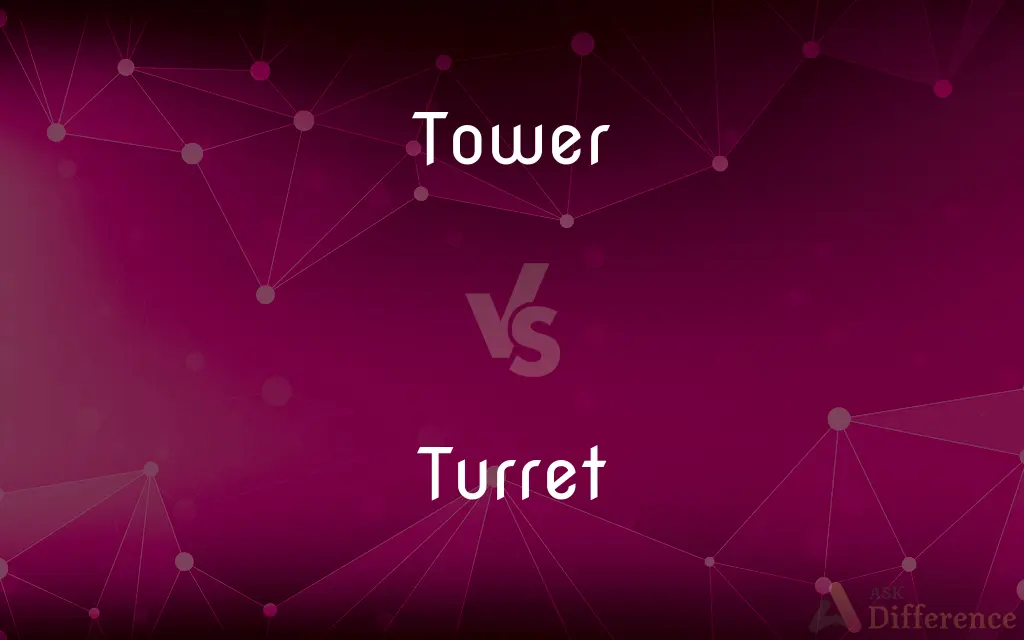Tower vs. Turret — What's the Difference?
By Tayyaba Rehman — Updated on November 3, 2023
A tower is a tall, standalone structure, often higher than it is wide, while a turret is a small tower attached to a building or wall, usually as a defensive feature.

Difference Between Tower and Turret
Table of Contents
ADVERTISEMENT
Key Differences
A tower is a tall structure that often stands independently or as part of a larger structure like a church or skyscraper. It is usually distinguished by its significant height and can serve various functions such as observation, communication, or ceremonial purposes. A turret, on the other hand, is a smaller tower that projects vertically from the wall of a building, typically a castle or fortress, and is designed for providing a vantage point and defense.
Towers have been a part of human architecture for millennia, used as lighthouses, bell towers, or minarets. These structures are often iconic landmarks due to their height and stand-alone prominence. Turrets, conversely, are more integrated into the building's design and are often used in military architecture to provide a high, protected point from which to defend the structure.
The design of a tower is such that it can be the main feature of a building, like the towers of a cathedral, or completely separate, like a water tower. Towers can be made of various materials, including stone, brick, steel, or wood. Turrets are generally made of the same materials as the buildings to which they are attached and are designed to blend with the overall architectural style.
While towers can be accessed from the inside, they often have internal stairs or elevators. They can be habitable or uninhabitable spaces, depending on their purpose. Turrets are traditionally accessed only from within the building and are designed for utilitarian purposes, offering a panoramic view for defense or surveillance.
In modern times, the term "tower" can refer to skyscrapers and communication towers, reflecting a broader utility beyond the traditional forms. Turrets are now mostly architectural features that add aesthetic value and historical character to modern structures, and their defensive role is largely obsolete.
ADVERTISEMENT
Comparison Chart
Standalone Structure
Yes, often stands independently.
No, attached to a larger structure.
Primary Function
Varied: defense, observation, etc.
Primarily defense and observation.
Size
Generally larger and taller.
Smaller, subordinate to main building.
Architectural Integration
Can be a central or separate feature.
Integrated into the building's design.
Historical Usage
Symbolic, religious, functional.
Mainly military and defensive.
Compare with Definitions
Tower
A tall, narrow structure, either freestanding or forming part of a building.
The clock tower stood proudly in the town square.
Turret
An ornamental structure resembling a small tower on a building.
The Victorian house featured a charming corner turret.
Tower
A tower is a tall structure, taller than it is wide, often by a significant factor. Towers are distinguished from masts by their lack of guy-wires and are therefore, along with tall buildings, self-supporting structures.
Turret
A projecting fortified structure on a tower or fortification.
Archers shot arrows from the turret to defend the castle.
Tower
A tall, narrow building, either free-standing or forming part of a building such as a church or castle
The south-west tower is a wonderful example of late Gothic
Turret
A small tower on top of a larger tower or building, often circular.
The castle's turret was a strategic lookout point in medieval times.
Tower
A tall structure that houses machinery, operators, etc.
A control tower
Turret
A small tower that projects from the wall of a building.
The stone turret added a gothic feel to the old mansion.
Tower
Rise to or reach a great height
He seemed to tower over everyone else
Turret
In architecture, a turret (from Italian: torretta, little tower; Latin: turris, tower) is a small tower that projects vertically from the wall of a building such as a medieval castle. Turrets were used to provide a projecting defensive position allowing covering fire to the adjacent wall in the days of military fortification.
Tower
(of a bird) soar to a great height, especially (of a falcon) so as to be able to swoop down on the quarry.
Turret
A small tower on top of a larger tower or at the corner of a building or wall, typically of a castle
A castle with fairy-tale turrets
Tower
A building or part of a building that is exceptionally high in proportion to its width and length.
Turret
A small tower or tower-shaped projection on a building.
Tower
A tall, slender structure used for observation, signaling, or pumping.
Turret
A low, heavily armored structure, usually rotating horizontally, containing mounted guns and their gunners or crew, as on a warship or tank.
Tower
One that conspicuously embodies strength, firmness, or another virtue.
Turret
A domelike gunner's enclosure projecting from the fuselage of a combat aircraft.
Tower
(Computers) A computer system whose components are arranged in a vertical stack and housed in a tall, narrow cabinet.
Turret
A tall wooden structure mounted on wheels and used in ancient warfare by besiegers to scale the walls of an enemy fortress.
Tower
To appear at or rise to a conspicuous height; loom
"There he stood, grown suddenly tall, towering above them" (J.R.R. Tolkien).
Turret
An attachment for a lathe consisting of a rotating cylindrical block holding various cutting tools.
Tower
To fly directly upward before swooping or falling. Used of certain birds.
Turret
A rotating device holding various lenses, as for a microscope, allowing easy switching from one lens to another.
Tower
To demonstrate great superiority; be preeminent
Towers over other poets of the day.
Turret
(architecture) A little tower, frequently a merely ornamental structure at one of the corners of a building or castle.
Tower
A very tall iron-framed structure, usually painted red and white, on which microwave, radio, satellite, or other communication antennas are installed; mast.
Turret
A siege tower; a movable building, of a square form, consisting of ten or even twenty stories and sometimes one hundred and twenty cubits high, usually moved on wheels, and employed in approaching a fortified place, for carrying soldiers, engines, ladders, casting bridges, and other necessaries.
Tower
A similarly framed structure with a platform or enclosed area on top, used as a lookout for spotting fires, plane crashes, fugitives, etc.
Turret
(electronics) A tower-like solder post on a turret board (a circuit board with posts instead of holes).
Tower
A water tower.
Turret
(military) An armoured, rotating gun installation on a fort, ship, aircraft, or armoured fighting vehicle.
Tower
A control tower.
Turret
(railroads) The elevated central portion of the roof of a passenger car, with sides that are pierced for light and ventilation.
Tower
Any very tall building or structure; skyscraper.
The Sears Tower
Turret
A little tower, frequently a merely ornamental structure at one of the angles of a larger structure.
Tower
(figuratively) An item of various kinds, such as a computer case, that is higher than it is wide.
Turret
A movable building, of a square form, consisting of ten or even twenty stories and sometimes one hundred and twenty cubits high, usually moved on wheels, and employed in approaching a fortified place, for carrying soldiers, engines, ladders, casting bridges, and other necessaries.
Tower
(informal) An interlocking tower.
Turret
A revolving tower constructed of thick iron plates, within which cannon are mounted. Turrets are used on vessels of war and on land.
Tower
(figurative) A strong refuge; a defence.
Turret
The elevated central portion of the roof of a passenger car. Its sides are pierced for light and ventilation.
Tower
(historical) A tall fashionable headdress worn in the time of King William III and Queen Anne.
Turret
A small tower extending above a building
Tower
(obsolete) High flight; elevation.
Turret
A self-contained weapons platform housing guns and capable of rotation
Tower
The sixteenth trump or Major Arcana card in many Tarot decks, usually deemed an ill omen.
Turret
A rotating tower on a tank or warship that houses guns.
The tank's turret turned to aim at the distant target.
Tower
(cartomancy) The nineteenth Lenormand card, representing structure, bureaucracy, stability and loneliness.
Tower
One who tows.
Tower
(intransitive) To be very tall.
The office block towered into the sky.
Tower
(intransitive) To be high or lofty; to soar.
Tower
To soar into.
Tower
A mass of building standing alone and insulated, usually higher than its diameter, but when of great size not always of that proportion.
Tower
A citadel; a fortress; hence, a defense.
Thou hast been a shelter for me, and a strong tower from the enemy.
Tower
A headdress of a high or towerlike form, fashionable about the end of the seventeenth century and until 1715; also, any high headdress.
Lay trains of amorous intriguesIn towers, and curls, and periwigs.
Tower
High flight; elevation.
Tower
To rise and overtop other objects; to be lofty or very high; hence, to soar.
On the other side an high rock towered still.
My lord protector's hawks do tower so well.
Tower
To soar into.
Tower
A structure taller than its diameter; can stand alone or be attached to a larger building
Tower
Anything tall and thin approximating the shape of a column or tower;
The test tube held a column of white powder
A tower of dust rose above the horizon
A thin pillar of smoke betrayed their campsite
Tower
A powerful small boat designed to pull or push larger ships
Tower
Appear very large or occupy a commanding position;
The huge sculpture predominates over the fountain
Large shadows loomed on the canyon wall
Tower
A structure taller than its diameter and high relative to its surroundings.
The observation tower offered panoramic views of the city.
Tower
A tall building or part of a building used for a specific purpose.
The university's library tower houses rare manuscripts.
Tower
A high structure used for communication or broadcasting signals.
The radio tower broadcasts signals across the region.
Tower
A structure that provides a commanding view of its surroundings.
The guard tower allowed a clear view of the approaching horizon.
Common Curiosities
What is the primary purpose of a tower?
Towers serve various purposes, including defense, observation, communication, and as architectural features.
Can a turret be a separate structure?
No, turrets are specifically small towers attached to buildings, not standalone structures.
Are towers only used for defense?
No, towers have diverse uses beyond defense, including as landmarks, observatories, and more.
Do turrets have modern applications?
Yes, turrets can be found in modern architecture as aesthetic features, though their defensive role is outdated.
Did turrets serve any purpose besides defense?
Historically, turrets also served as lookout points and status symbols.
Can a tower be a living space?
Yes, some towers are designed to be habitable, with apartments or offices.
How do towers affect a city's skyline?
Towers often define a city's skyline due to their significant height and prominence.
What is the tallest tower in the world?
As of my last update, the Burj Khalifa in Dubai holds the record for the tallest tower.
Can turrets be functional in modern warfare?
Modern warfare rarely uses fixed turrets; mobile, mechanized turrets on vehicles are more common.
Are turrets found on all castles?
While common, not all castles have turrets; their presence depends on the specific design and period.
What materials are used to build towers?
Towers can be constructed from stone, brick, steel, wood, and modern materials like reinforced concrete.
Have towers always been part of human architecture?
Yes, towers have been constructed throughout history for various purposes and remain integral to cityscapes.
What architectural styles feature turrets prominently?
Gothic, Victorian, and medieval fortress architectures often feature turrets.
Are turrets always round?
No, turrets can be various shapes, though round is common for older fortifications.
Do modern homes incorporate turrets?
Some modern homes include turrets for stylistic reasons, paying homage to historical architecture.
Share Your Discovery

Previous Comparison
Admire vs. Aspire
Next Comparison
Opinion vs. JudgingAuthor Spotlight
Written by
Tayyaba RehmanTayyaba Rehman is a distinguished writer, currently serving as a primary contributor to askdifference.com. As a researcher in semantics and etymology, Tayyaba's passion for the complexity of languages and their distinctions has found a perfect home on the platform. Tayyaba delves into the intricacies of language, distinguishing between commonly confused words and phrases, thereby providing clarity for readers worldwide.















































